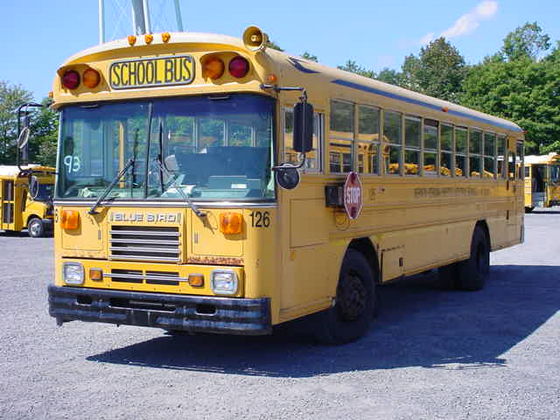
Overview Who Needs This? Excerpts Order Book Pictures Chapters
Answers Reviews Destinations Free Stuff More Contact Us
Before creating the Vanabode travel style I ran a motorcoach website. This page is one of many bus articles I wrote for coach buyers before closing that website.
School Bus for Sale Buyers Guide
See the school bus for sale sign and you are ready to buy one to convert to a recreational vehicle, church transportation bus, live aboard unit or business, one should be aware of some of the advantages and disadvantages of this particular platform. If you haven't read our Seven Commandments for buying a bus - read that first! These commandments of advice will save you thousands of dollars and a lifetime of headaches.
If you haven't seen our bus make and model quick reference chart - read that first! It identifies most major makes and models of buses, complete with a list of advantages and disadvantages. For instance, newer school buses offer huge advantages in price over traditional motorcoaches used by the tour industry, parts are readily available, and they are easy to locate and purchase. However they do have limitations you should be aware of.

Storage Space - Most school bus body styles and frames do not support the installation of adequate storage space for full time live aboard accommodations. However there is plenty of room to build above floor storage in buses to be used for weekend trips, flea market or race attendance buses. Some newer diesel school buses do have factory built storage underneath like commercial passenger buses and these are especially interesting for conversion candidates.
Cheer up, my uncle and aunt traveled the country and lived full time in their converted school bus for 10 years. And they still talk fondly of it. You can have a successful experience as well. Just follow our advice, buy wisely, do your homework, build smart, and stay within budget.
If you can live with the limitations, great. School buses can be the least expensive way to buy a shell. But if you cannot live with shortcomings don't try to fudge it because if the bus can't meet your needs, you'll never be happy, at any price. You could end up with a pathetic project sitting in your back yard instead of a great recreational vehicle to enjoy and make memories with.
Body Style - Conventional verses Flat-Front Pusher. Flat-Front pushers are easier to sell and most people like the profile better. They may offer more room for the same length bus also. Check out the visibility difference. The entrance door positions vary as well. The rear pusher buses offer a quieter ride. The conventional flip-front with its more "school bus look" does offer better engine access (which translates into cheaper service). They are easier to steer and cheaper.
When buying a school bus from a school district or municipal government you have a number of issues to consider. First you have to decide which type bus you want (we will discuss this later) then you decide budget and begin research on the individual units in consideration. Just because a school bus is being sold at an auction doesn't mean it's a worn out piece of junk. Usually due to insurance reasons they have been maintained quite well. At this stage trying to save a few bucks on the foundation is unwise. If you need to skimp do so on the cosmetics later. The church kids aren't going to care if they sit on vinyl or leather, but schedule a big event and have the bus breakdown due to faulty brakes, and they'll never forget it. Your spouse may not mind that the bed mattress you put in is lightweight foam, but if the bus won't start, you won't be using the bed at all.
So, you have access to an auction list or an inventory of used buses, or you have an individual bus in mind. Ask for service records, original paperwork, and recent repair receipts. Everything in the paper trail will help you determine value and avoid potential problems. It will also reward you with some eye opening information.
Carefully look through the paperwork and avoid the purchase of buses with no paper trail at all. Look for weird situations. Finding a receipt for an AC charge might be good, if its recent. Come across receipts for an AC charge done three times in the last year and you have a problem. If the receipts don't have the bus VIN on them how do you know the receipts are for the bus your looking at.
Rule of thumb when buying a bus for one tenth the original price. BUDGET for parts an labor on ANY mechanical part for which you don't have a good history, receipt trail, or ability to inspect. In other words if you can't verify its condition then don't buy the bus unless you can afford to replace it, part by part. That means: AC, brakes, hydraulic lines, engine compression, transmission condition, steering and front end parts, electrical system from the wiring harness to the gauges, alternator and fuse panels, tires, body, and glass, air compressor buildup and recovery times, and many other items your mechanic can advise you about.
It is possible to buy a bus for $5,000 that originally sold for over $70,000. With such a great bargain to begin with, you really shouldn't purchase anything but the best foundation for your project that you can find. You may later choose to spend $10,000 to $30,000 or hundreds of hours of your time on converting or customizing the bus. Do you really want to build on a shell that has a bad frame? Do you really want to invest so much in a bus that has a bad engine or transmission that you constantly fight with?
Rust - When buying a used school bus remember rust cannot be stopped easily. Rust does not rest. Rust MUST be taken seriously no matter how cheap your bus candidate is. You cannot always sheet metal and bondo your way to a permanent fix. Some rust on the body surface may be acceptable. Do not accept structural rust in important areas of suspension or engine mounts, heavily rusted frames, or rusted through hood hinge mounts, anything that would be a major problem when (not if) it gets twice as bad as it is now. Surface rust can be fixed and body panels that are too rusted to fix can be replaced with original manufacturers parts, custom made sheet metal parts from your local sheet metal fabricator or welder or with aftermarket fiberglass panels. Just budget for the repairs.
Even if you are a welder and could correct serious issues with rust I strongly advise against it. Find a better shell to start with an spend your time, money and patience, on other, more enjoyable bus modifying tasks. Unless of course body work is the part you enjoy the most then by all means repair away AND make some cool adjustments along the way if you please, like blanking in some windows, modifying the accent lines, or adjusting the fenders.
Service Record - If it's been in fleet use, it has one. If you're buying from a middle man and he can't produce it - you've got problems - possibly serious ones. If not, he'd be proudly displaying the records. Check how long since the engine rebuild - they last about 60 -100,000 miles, depending on whether they are driven stop and go in the mountains or over long stretches of flat highway.
Leaks - Look for ANY signs of leaks, particularly from Automatic Transmissions. Some Allison transmissions used in buses have wimpy front seals and leak constantly when the transmission gets really hot. Don't buy a bus with a leaky transmission. A replacement Allison can cost $4,000 parts and labor. Leaking brake components or hydraulic systems can be expensive to repair also.
Engine - get the biggest engine you can afford, especially if you are adding conversion weight to the vehicle. There is NO substitute for size (raw cubic inches) I don't care what the ads say. My car has a 440 in it why would you buy a 65 passenger bus with a 318 if you really need the power say for climbing hills or mountain passes on nice scenic trips? Some believe the smaller engines produce better fuel mileage, I agree, until you add $12,000 pounds of conversion parts.
Size - When it comes to underpowered school buses which are going to get nothing but heavier as you modify them, longer is NOT always better. Sure it gives you more room, but remember the bus might have been fine originally but now you've added 12,000 pounds of modifications. Weight issues in a school bus should not be ignored, or underestimated. Build it too heavy and it won't steer right, will destroy the engine and transmission, will eat up the tires, smoke the brakes, and flatten the suspension. Now was it really necessary to get the super 72 seater and fill it full of fuzzy dice, furniture and fixings?


Home
Contact Us Copyright
© 2007-2016 Free
Guide They Hate Me
Privacy
Policy Terms
and Conditions Media
Press Affiliate